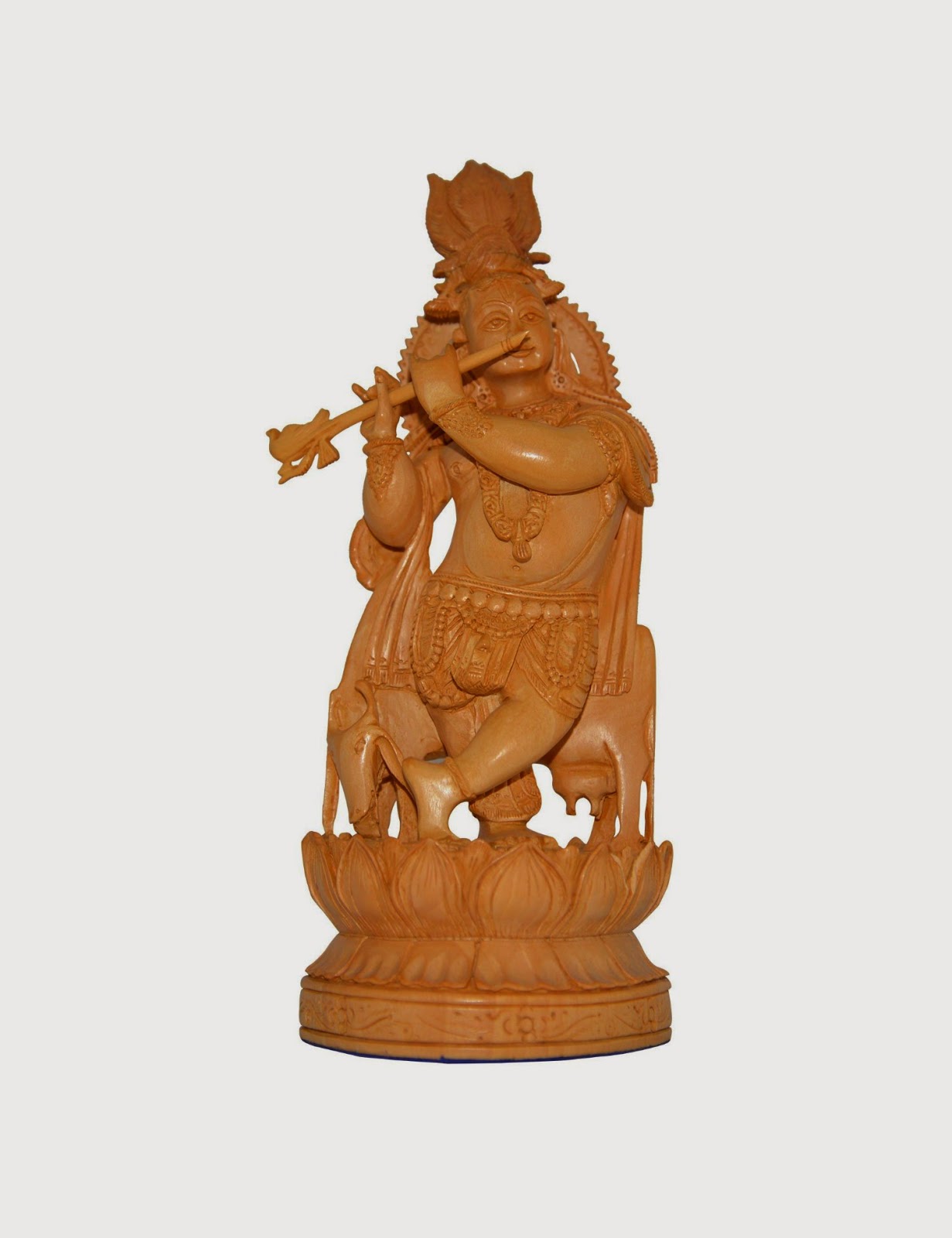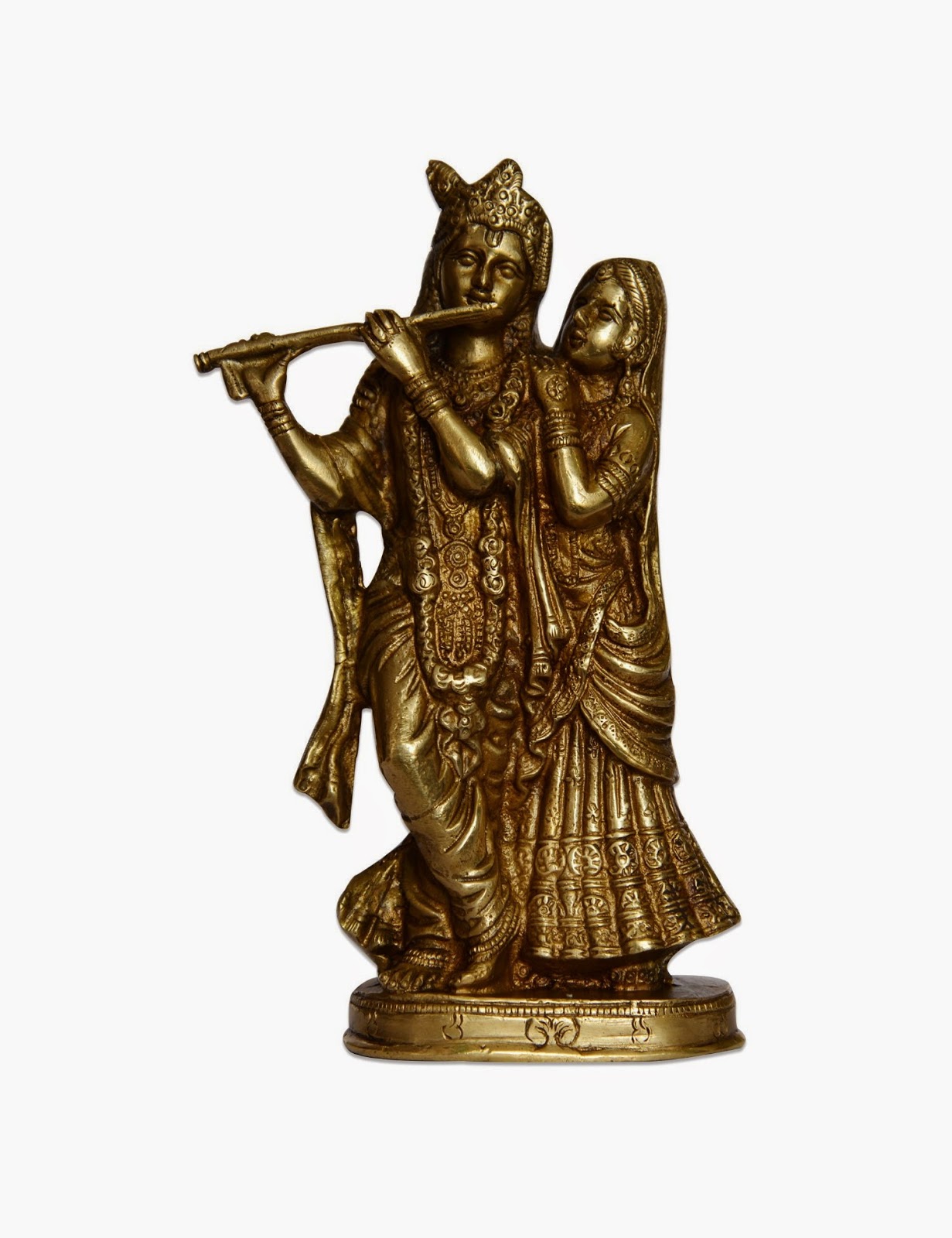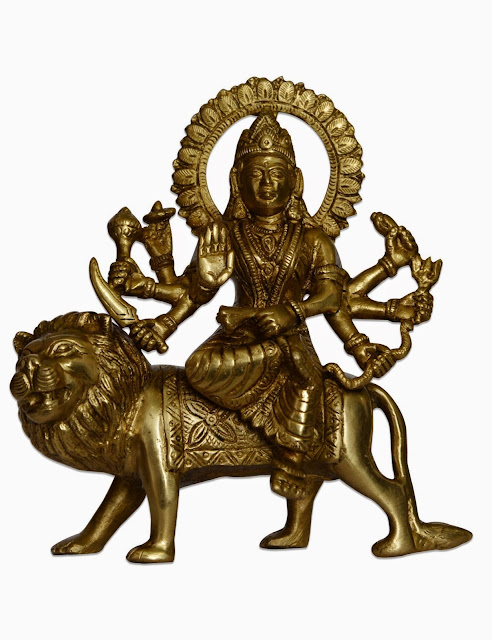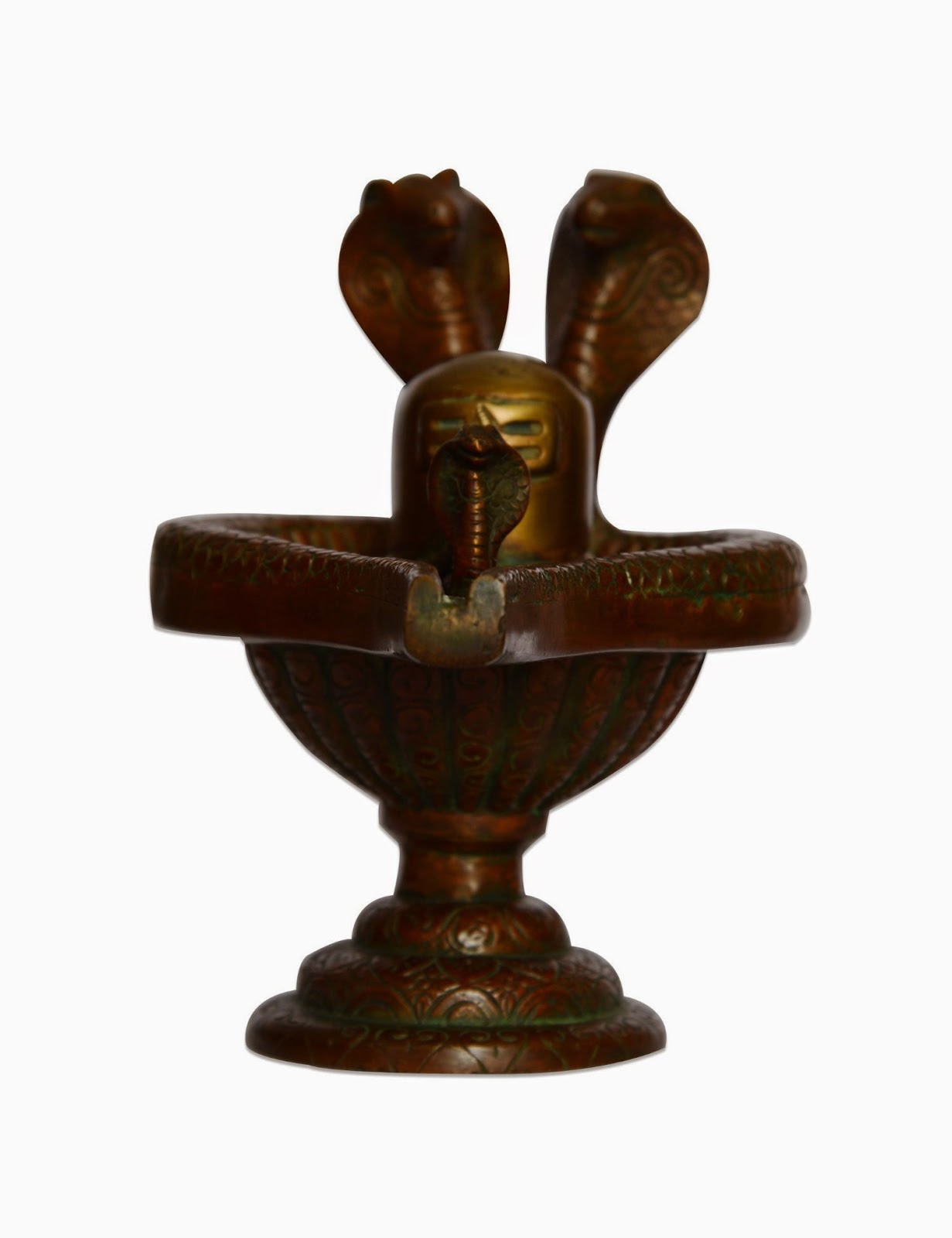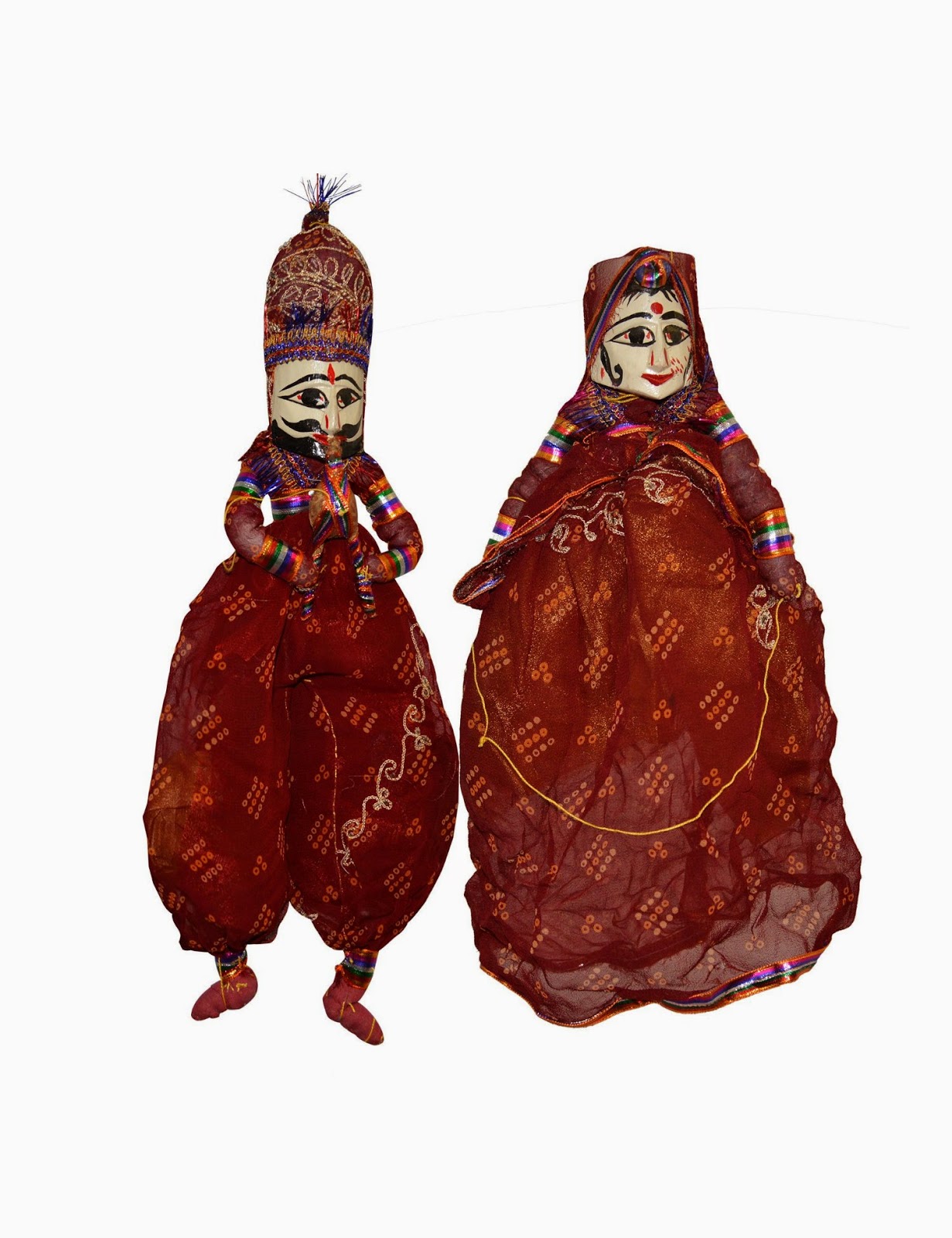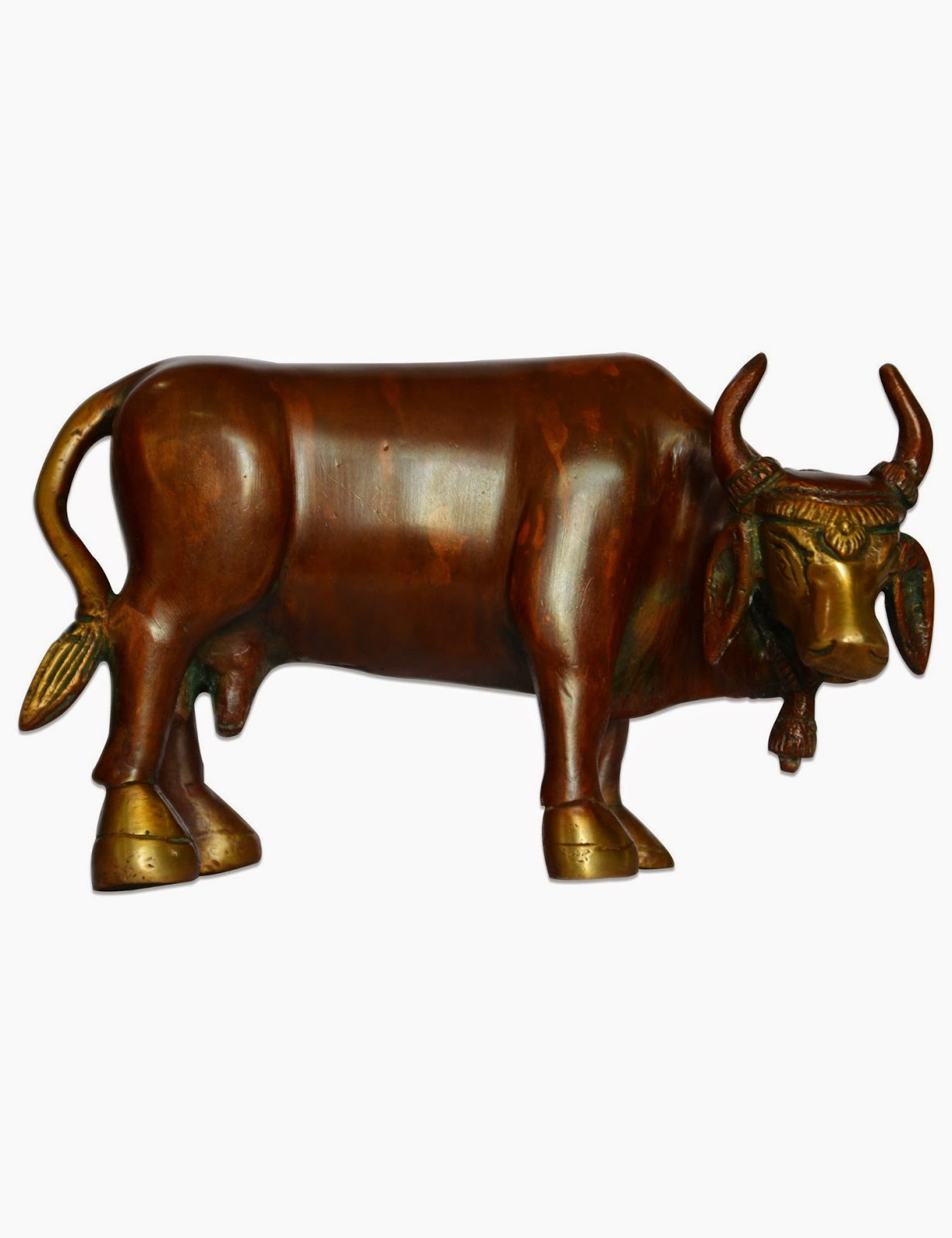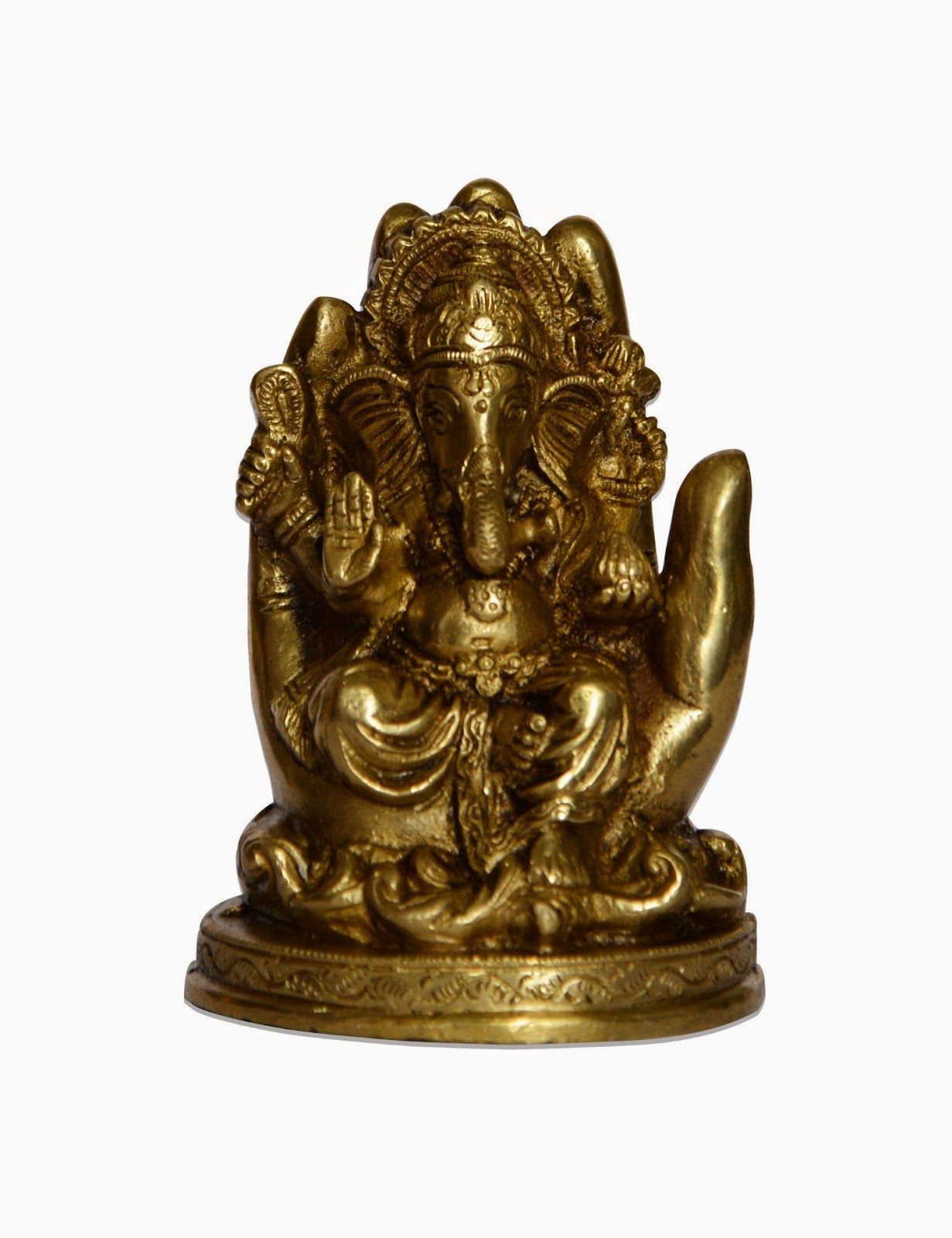Nanda was the head of a community of cow-herders, and he settled in Vrindavana. The stories of Lord Krishna's childhood and youth tell how he became a cow herder, his mischievous pranks as Makhan Chor (butter thief), his foiling of attempts to take his life, and his role as a protector of the people of Vrindavana.
Shri Krishna killed many Rakshasha's sent by Kansa (king of Mathura).
Krishna lifted the Govardhana hill to protect villagers of village vrindavan from the anger of Indra.
Shri Krishna’s childhood reinforces the Hindu concept of lila, playing for fun and enjoyment and not for sport or gain. His interaction with the gopis at the rasa dance or Rasa-lila . Krishna played his flute and the gopis came immediately from whatever they were doing, to the banks of the Yamuna River, and joined him in singing and dancing. Even those who could not physically be there joined him through meditation.
Saturday, 19 April 2014
Birth History Of Shree Krishna
Lord Krishna
was born to Devaki and her husband, Vasudeva Because of his sympathy for
the earth, the divine God Vishnu himself descended into the womb of Devaki and
was born as her son kanha (krishna),By the time of conception and birth of
Krishna, Devaki was married to Vasudeva and had already borne 7 children. The
Hindu Vishnu Purana relates: "Devaki bore in her womb the lotus-eyed
deity...before the birth of Shri Krishna, no one “could bear to gaze upon
Devaki, from the light that invested her, and those who contemplated her
radiance felt their minds disturbed.” This reference to light is reminiscent of
the Vedic hymn "To an Unknown God," which refers to a Golden Child.Krishna
belonged to the Vrishni clan of Yadavas from Mathura, and was the eighth son
born to the princess Devaki, and her husband Vasudeva.
Mathura
( district, Uttar Pradesh) was the capital of the Yadavas, to which Shri
Krishna's parents Vasudeva and Devaki belonged. King Kansa, Devaki's brother,
had ascended the throne by imprisoning his father, King Ugrasena. Afraid of a
prophecy from a divine voice from the heavens that predicted his death at the
hands of Devaki's eighth "garbha", Kamsa had the couple locked into a
prison cell. After Kansa killed the first six children, Devaki apparently had a
miscarriage of the seventh. However in reality, the womb was actually
transferred to Rohini secretly. This was how Balarama, Shri Krishna's elder
brother was born. Once again Devaki became pregnant. Now due to the
miscarriage, Kansa was in a puzzle regarding 'The Eighth One' but his ministers
advised that the divine voice from the heavens emphasised "the eight
garbha" and so this is the one. That night Krishna was born in the Rohini
nakshatra and simultaneously Goddess Durga was born as Yogamaya in Gokulam to
Nanda (Respectable person of Gokul village) and Yashoda (Nanda's wife). Since
Vasudeva knew Krishna's life was in danger, Krishna was secretly taken out of
the prison cell to be raised by his foster parents, Yasoda and Nanda, in Gokula
( Mathura district). Two of his other siblings also survived, Balarama
(Devaki's seventh child, transferred to the womb of Rohini, Vasudeva's first
wife) and Subhadra (daughter of Vasudeva and Rohini, born much later than
Balarama and Krishna).
Labels:
Achala,
Gopala,
Govinda,
Kanahiya,
Keshava,
Lord Krishna,
Madhusudhana.,
Manohar,
Murlidhar,
Nandlal
Location:
Gurgaon, Haryana, India
Names of Lord Krishna
Some Names of Lord Krishna :-
NAMES MEANING
Achala Still Lord
Anandsagar Compassionate Lord
Ananta The Endless Lord
Balgopal The Child Krishna, The All Attractive
Bali The Lord Of Strength
Chaturbhuj Four-Armed Lord
Devakinandan Son Of Mother Devaki
Dwarkapati Lord Of Dwarka
Gopal One Who Plays With The Cowherds, The Gopas
Govinda One Who Pleases The Cows
Hari The Lord Of Nature
Jagannath Lord Of The Universe
Kamalnayan The Lord With Lotus Shaped Eyes
Krishna Dark-Complexioned Lord
Lakshmikantam The Lord Of Goddess Lakshmi
Madan The Lord Of Love
Madhava Knowledge Filled God
Madhusudan Slayer Of Demon Madhu
Manmohan All Pleasing Lord
Murlidhar One Who Holds The Flute
Murlimanohar The Flute Playing God
Nandgopala The Son Of Nand
Narayana The Refuge Of Everyone
Paramatma Lord Of All Beings
Shyam Dark-Complexioned Lord
Shyamsundara Lord Of The Beautiful Evenings
Sudarshana Handsome Lord
Vaikunthanatha Lord Of Vaikuntha, The Heavenly Abode
Vishwatma Soul Of The Universe
NAMES MEANING
Achala Still Lord
Anandsagar Compassionate Lord
Ananta The Endless Lord
Balgopal The Child Krishna, The All Attractive
Bali The Lord Of Strength
Chaturbhuj Four-Armed Lord
Devakinandan Son Of Mother Devaki
Dwarkapati Lord Of Dwarka
Gopal One Who Plays With The Cowherds, The Gopas
Govinda One Who Pleases The Cows
Hari The Lord Of Nature
Jagannath Lord Of The Universe
Kamalnayan The Lord With Lotus Shaped Eyes
Krishna Dark-Complexioned Lord
Lakshmikantam The Lord Of Goddess Lakshmi
Madan The Lord Of Love
Madhava Knowledge Filled God
Madhusudan Slayer Of Demon Madhu
Manmohan All Pleasing Lord
Murlidhar One Who Holds The Flute
Murlimanohar The Flute Playing God
Nandgopala The Son Of Nand
Narayana The Refuge Of Everyone
Paramatma Lord Of All Beings
Shyam Dark-Complexioned Lord
Shyamsundara Lord Of The Beautiful Evenings
Sudarshana Handsome Lord
Vaikunthanatha Lord Of Vaikuntha, The Heavenly Abode
Vishwatma Soul Of The Universe
Labels:
Achala,
Gopala,
Govinda,
Kanahiya,
Keshava,
Lord Krishna,
Madhusudhana.,
Manohar,
Murlidhar,
Nandlal
Location:
Gurgaon, Haryana, India
Lord Krishna - Kanahiya- eighth incarnation of Lord Vishnu
Labels:
Achala,
Gopala,
Govinda,
Kanahiya,
Keshava,
Lord Krishna,
Madhusudhana.,
Manohar,
Murlidhar,
Nandlal
Location:
Gurgaon, Haryana, India
Friday, 18 April 2014
Maa Durga - The Adi-shakti of Vedas
Goddess Durga mean "the inaccessible or "the
invincible. Maa Durga is the most popular incarnation of Devi and one of the
main forms of the Goddess Shakti in the Hindu pantheon. Durga is the original
manifested form of Mother Adi-Parashakti. She is Adi- Parashakti herself. The
Devi Gita declares her to be the greatest Goddess. Thus, she is considered the
supreme Goddess and primary deity in Shaktism, occupying a place similar to
Lord Krishna in Vaishnavism. According to Skanda Purana, Goddess Parvati
accounted the name 'Durga' after she killed the demon Durgamaasura. Goddess
Parvati is considered to be the complete incarnation of Adi Parashakti or
Goddess Durga, with all other Goddesses being her incarnations or
manifestations. Whatever deity one is worshiping, ultimately, they are
worshiping her. Adi Parashakti or Mahadevi, the Supreme power, is called Durga
Shakti as per Devi-Mahatmya. Adi parashakti or Devi Durga is a Hindu concept of
the Ultimate Shakti or Mahashakti, the ultimate power inherent in all Creation.
According to Markandeya Purana she is Goddess Lakshmi and Goddess Saraswati in
her mild form; Goddess Kali and Goddess Chandi in her wrathful form.
Thursday, 17 April 2014
Handmade Rajasthani Damroo - Musical Instrument.
A damaru or damroo is a small two-headed drum, used in
Hinduism and Tibetan Buddhism. Damru is known as the instrument of Lord Shiva. Damru
was first created by Shiva to produce spiritual sounds by which this whole
universe has been created and regulated. The drum (damru) is typically made of
wood, with leather drum heads at both ends; the damaru might also be made
entirely out of human skulls. The resonator is made of brass. The height of the
damru is 6 inches and weight varies from 250-330 gm. Its height ranges from a
few inches to a little over one foot. It is played single headedly. The
strikers are typically beads fastened to the ends of leather cords around the
waist of the damaru. Knots in the leather can also be used as strikers, also
crochet material is common. As the player waves the drum using a twisting wrist
motion, the strikers beat on the drumhead. The damaru is very common throughout
the Indian subcontinent. The damaru is known as a power drum, and when played,
it is believed to generate spiritual energy. It is associated with the Hindu
deity Shiva. It is believed that Sanskrit language was recognized by the
drumbeats of the damaru (see Shiva Sutra for the sounds), and His performance
of the cosmic dance of tandava. The damaru is used by itinerant musicians of all
stripes, due to its small portable size. In the shield shape of some damaru’s,
the triangular upward representation also symbolizes male procreativity (the
Lingam), and the downward round representation symbolizes the female
procreativity (the Yoni). Symbolically, the creation of the world begins when
the lingam and yoni meet at the midpoint of the damaru, and the destruction
takes place when they separate from each other.
Labels:
Damaru,
Damroo,
Damru,
power drum.
Location:
Gurgaon, Haryana, India
Wednesday, 16 April 2014
Handmade Rajasthani Silk Table Runner
Table
runner is a long strip of cloth that is put down the middle of the table,
lengthways, to decorate it and to protect the surface from dishes, etc. We use
Table runner on a special occasion’s for decorations, a table runner is a simple
solution to cover a table and add colour or reflect a theme. There's no need
for a tablecloth when a runner is used; however, a formal table with a
tablecloth becomes more decorative with a runner. A white tablecloth topped
with a coloured runner is a simple choice. Runners also work well for
everyday use and will change a bare table into one with modest charm.
Themed table runners are available for holidays, birthdays or special events. A
simple red, white and blue runner is an option for a July Fourth celebration,
for instance.
Tuesday, 15 April 2014
Shivling- Handmade Lord Shiva Figurine in Brass
Shivling is a mountain in the Gangotri Group of peaks in the
western Garhwal Himalaya, near the snout of the Gangotri Glacier. It lies in
the northern Indian state of Uttarakhand, 6 kilometres (4 mi) south of the
Hindu holy site of Gaumukh (the source of the Bhagirathi River). Its name
refers to its status as a sacred symbol of the God - Lord Shiva's Shiva Linga.
It was called "Matterhorn Peak" by early European visitors because of
its similarity in appearance to that Alpine peak. While not of locally great elevation,
it is a dramatic rock peak, and most visually striking peak seen from Gaumukh;
that and the difficulty of the climb make it a famed prize for mountaineer
Labels:
Shiva Lingum,
Siva Linga,
Sivalingam
Location:
Gurgaon, Haryana, India
Kathputli - Hand crafted colourful Puppet
A puppet is an inanimate object or representational figure
animated or manipulated by a puppeteer.
It is used in puppetry, which is a very
ancient form of theatre. A Kathputli show in Mandawa, Rajasthan, India. There
are many different varieties of puppets, and they are made of a wide range of
materials, depending on their form and intended use. They can be extremely
complex or very simple in their construction. Puppetry was practised in Ancient
Greece and the oldest written records of puppetry can be found in the works of
Herodotus and Xenophon, dating from the 5Th century B. The movements of animals
may be compared with those of automatic puppets, which are set going on the
occasion of a tiny movement; the levers are released, and strike the twisted
strings against one another. In India puppetry was practised from ancient times
and is known by different names in different parts of the country. Excavation
of clay dolls from Indus valley sites serve as an indication. The art of
puppetry called Bommalattam is mentioned in Tamil literature Silappadikaram,
which is written around 2nd century B.C. Puppetry by its nature is a flexible
and inventive medium, and many puppet companies work with combinations of
puppet forms, and incorporate real objects into their performances. They might,
for example, incorporate "performing objects" such as torn paper for
snow, or a sign board with words as narrative devices within a production. The
following are, alphabetically, the basic and conventional forms of puppet.
Location:
Gurgaon, Haryana, India
Monday, 14 April 2014
shenai or mangal vadya - Musical Instrument
The Shehnai, shahnai, shenai or mangal vadya is a double
reed oboe, common in India, Pakistan, Bangladesh and Iran, made out of wood,
with a metal flare bell at the end. Its sound is thought to create and maintain
a sense of auspiciousness and sanctity and, as a result, is widely used during
marriages, processions, and in temples, although it is also played in concerts.
Shenai is similar to South India's nadaswaram.This tubular instrument gradually
broadens towards the lower end. It usually has between six and nine holes. It
employs one set of quadruple reeds, making it a quadruple reed woodwind. By
controlling the breath, various tunes can be played on it. The shehnai has a
range of two octaves, from the A below middle C to the A one line above the
treble clef. The ancestor of North Indian shehnai is believed to be from
Persian Surna (Sur = feast, Nai=Ney= flute). The shehnai is thought to have
been developed by improving upon the pungi (a woodwind folk instrument used
primarily for snake charming).There are varying legends of the shehnai's
origin. In one of these, a shah initially banned the playing of the pungi in
his court due to its shrill sound. A barber, belonging to a family of
musicians, improved on it and created the shehnai. As it was played in the
Shah's court and giving due reference to the nai or barber, the new instrument
was called shehnai.
Labels:
Mangal Vadya.,
Shahnai,
Shehnai,
Shenai
Location:
Gurgaon, Haryana, India
Animal Figurine Cow ( Gau Mata )
GAU MATA
Cattle are considered sacred in world religions such as
Hinduism, Jainism, Zoroastrianism and others. The cow has been a symbol of
wealth since ancient days. However, they were neither inviolable nor revered in
the same way they are today. The cow was possibly revered because Hindus relied
heavily on it for dairy products and for tilling the fields, and on cow dung as
a source of fuel and fertilizer. Thus, the cow’s status as a 'caretaker' led to
identifying it as an almost maternal figure (hence the term gau mata). Hinduism
is based on the concept of omnipresence of the Divine and the presence of a
soul in all creatures, including bovines. Thus, by that definition, killing any
animal would be a sin: One would be obstructing the natural cycle of birth and
death of that creature, and the creature would have to be reborn in that same
form because of its unnatural death. Krishna, one of the incarnations of god in
Hindu mythology (Avatar), tended cows. The cow and bull represent the symbol of
Dharma. Reverence for cows and bulls are in the major texts of the Vedic
religion. In South India and some parts of Sri Lanka, a cattle festival is
celebrated. It is called as Mattu Pongal. The Sanskrit word for cattle is pasu.
Milk cows are also called Aghnya "that which may not be slaughtered .In
the Rig Veda, the cows figure frequently as symbols of wealth and in comparison
with river goddesses, like two bright mother cows that lick their young, Vipas
and Sutudri speed down their waters. “Atharva Veda the cow's body is
represented by devas and other subjects. The Harivamsha depicts Krishna as a
cowherd. He is often described as Bala Gopala, "the child who protects the
cows." Another of Krishna's names, Govinda, means "One who brings
satisfaction to the cows." Other scriptures identify the cow as the
"mother" of all civilization, its milk nurturing the population. The
gift of a cow is applauded as the highest kind of gift. The cow's milk is
believed to promote Sattvic (purifying) qualities. The ghee (clarified butter)
from the milk of a cow is used in ceremonies and in preparing religious food.
Cow dung is used as fertilizer, as a fuel and as a disinfectant in homes. Its
urine is used for religious rituals as well as medicinal purposes. The supreme
purificatory material, panchagavya, was a mixture of five products of the cow:
milk, curds, ghee, urine and dung Kamadhenu, the miraculous "cow of
plenty" and the "mother of cows" in Hindu mythology is believed
to represent the generic sacred cow, regarded as the source of all.
Labels:
cow,
Gau mata,
kaamdhenu.
Location:
Gurgaon, Haryana, India
Shree Ganesha - remover of obstacles
Although he is known by many attributes, Ganesha's elephant head makes him easy to identify. Lord Ganesha is widely revered as the remover of obstacles,the patron of arts and sciences and the deva of intellect and wisdom. As the god of beginnings, he is honoured at the start of rituals and ceremonies.
Shri Ganesha has been represented with the head of an elephant since the early stages of his appearance in Indian art. Puranic myths provide many explanations for how he got his elephant head.One of his popular forms, Heramba-Ganapati, has five elephant heads, and other less-common variations in the number of heads are known.While some texts say that Gajanan was born with an elephant head, he acquires the head later in most stories. The most recurrent motif in these stories is that Ganesha was created by Parvati using clay to protect her and Shiva beheaded him when Ganesha came between Shiva and Parvati. Shiva then replaced Ganesha's original head with that of an elephant. Details of the battle and where the replacement head came from vary from source to source. Another story says that Shri Ganesha was created directly by Shiva's laughter. Because Shiva considered Ganesha too alluring, he gave him the head of an elephant and a protruding belly.
shri Ganesha is shown riding on a mouse, shrew or rat. The Ganapati Atharvashirsa includes a meditation verse on Ganesha that describes the mouse appearing on his flag.The names Musakavahana (mouse-mount) and Akhuketana (rat-banner) appear in the Ganesha Sahasranama.
Labels:
Ekdanta,
Gajanan,
Ganpati,
Lambodar,
Lord Ganesha,
Shri ganesh,
Umasut.,
Vighnesh,
Vinayak
Location:
Gurgaon, Haryana, India
Tuesday, 8 April 2014
Embroided Designed Cotton Bedsheet
Embroidery is the handicraft of decorating fabric or other materials with needle and thread or yarn. Embroidery may also incorporate other materials such as metal strips, pearls, beads, quills, and sequins. Embroidery is most often used on caps, hats, coats, blankets, dress shirts, denim, stockings, and golf shirts. Embroidery is available with a wide variety of thread or yarn color
The fabrics and yarns used in traditional embroidery vary from place to place. Wool, linen, and silk have been in use for thousands of years for both fabric and yarn. Today, embroidery thread is manufactured in cotton, rayon, and novelty yarns as well as in traditional wool, linen, and silk. Ribbon embroidery uses narrow ribbon in silk or silk/organza blend ribbon, most commonly to create floral motifs.
 |
| Hand Embroidered Flat Sheet Floral Design Cotton Bedsheet |
Block Printed Bedsheets
Block printing on textiles is the process of printing patterns on textiles, usually of linen, cotton or silk, by means of incised wooden blocks.
It is the earliest, simplest and slowest of all methods of textile printing. Block printing by hand is a slow process.
It is, however, capable of yielding highly artistic results, some of which are unobtainable by any other method.
Woodblocks for textile printing may be made of box, lime, holly, sycamore, plane or pear wood, the latter three being most generally employed.
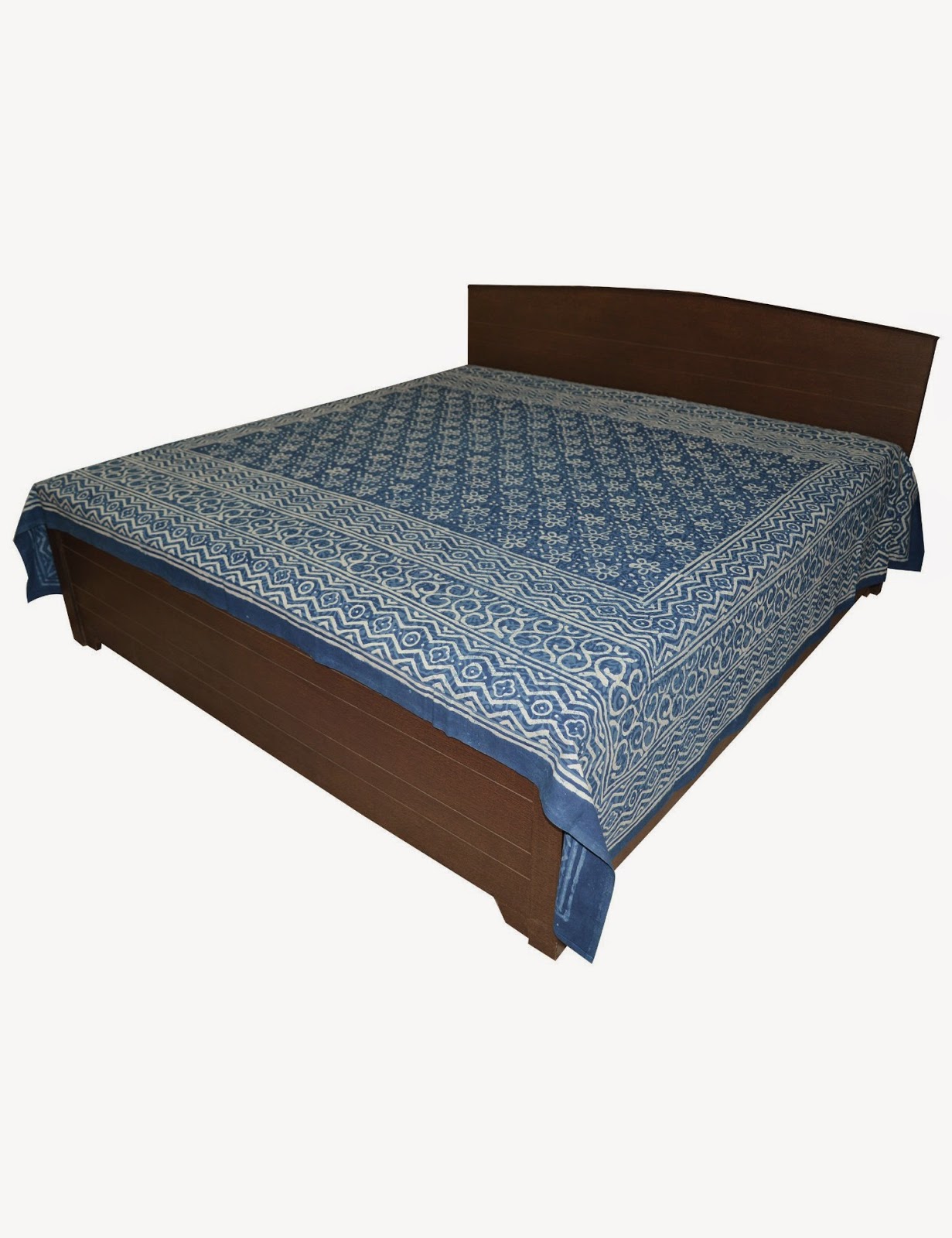 |
Dabu Print Design Cotton Flat Bed Sheet |
Thursday, 3 April 2014
God Hanuman Ji
God Hanuman is a Hindu god, who was an ardent devotee of Lord Rama. .
A vanara (monkey-like humanoid),Shri Hanuman participated in King Rama's war against the demon king Ravana.
Hanuman Ji was born to the humanoid creatures called the vanaras.
His mother Anjana was an apsara who was born on earth as a female vanara due to a curse.
She was redeemed from this curse on her giving birth to a son.
The Valmiki Ramayana states that his father Kesari was the son of Brihaspati and that Kesari also fought on Rama's side in the war against Ravana.
Anjana and Kesari performed intense prayers to Shiva to get a child. Pleased with their devotion, Shiva granted them the boon they sought.
Shri Hanuman, in another interpretation, is the incarnation or reflection of Lord Shiva himself.
Bhakt Hanuman came to be regarded as an avatar (incarnation) of Shiva by the 10th century.
Pawan Sut Hanuman is mentioned as an avatar of Lord Shiva or Rudra.
Bajrangbali (Hanuman) came to be portrayed as the ideal devotee (bhakta) of Rama.
His characterization as a lifelong brahmachari (celibate) was another important development.
The belief that Hanuman's celibacy is the source of his strength became popular among the wrestlers in India.
A vanara (monkey-like humanoid),Shri Hanuman participated in King Rama's war against the demon king Ravana.
Hanuman Ji was born to the humanoid creatures called the vanaras.
His mother Anjana was an apsara who was born on earth as a female vanara due to a curse.
She was redeemed from this curse on her giving birth to a son.
The Valmiki Ramayana states that his father Kesari was the son of Brihaspati and that Kesari also fought on Rama's side in the war against Ravana.
Anjana and Kesari performed intense prayers to Shiva to get a child. Pleased with their devotion, Shiva granted them the boon they sought.
Shri Hanuman, in another interpretation, is the incarnation or reflection of Lord Shiva himself.
Bhakt Hanuman came to be regarded as an avatar (incarnation) of Shiva by the 10th century.
Pawan Sut Hanuman is mentioned as an avatar of Lord Shiva or Rudra.
Bajrangbali (Hanuman) came to be portrayed as the ideal devotee (bhakta) of Rama.
His characterization as a lifelong brahmachari (celibate) was another important development.
The belief that Hanuman's celibacy is the source of his strength became popular among the wrestlers in India.
Lord Vishnu - the Protector of Universe
As we all know that Lord Vishnu is known as the supreme God of Vaishnavism. Shri Vishnu is also known as Narayana and Hari. Goddess Laksmi is the wife of Lord Vishnu.
Lord Vishnu is usually described as having the divine blue color of water-filled clouds and as having four arms. He is depicted as holding a padma(lotus) in the lower left hand, gada(mace) in the lower right hand, a shankha(counch) in the upper left hand and Sudarshana Chakra(disk) in the upper right hand.

He owns pancha ayudham (5 Weapons): Sudarshanam, Panchajanyam, Komodaki, Nandakam, Shaarngam.
Lord Vishnu is the Supreme God who takes manifest forms or avatars across various ages or periods to save humanity from evil beings and some of the Avtaars are:-
It is written in the scriptures about Lord Vishnu that -
'Shantakaram Bhujagshayanam’
This means quiet Vishnu resting on the serpent (Sheshnag).
Lord Vishnu is usually described as having the divine blue color of water-filled clouds and as having four arms. He is depicted as holding a padma(lotus) in the lower left hand, gada(mace) in the lower right hand, a shankha(counch) in the upper left hand and Sudarshana Chakra(disk) in the upper right hand.

He owns pancha ayudham (5 Weapons): Sudarshanam, Panchajanyam, Komodaki, Nandakam, Shaarngam.
Lord Vishnu is the Supreme God who takes manifest forms or avatars across various ages or periods to save humanity from evil beings and some of the Avtaars are:-
- Narayan
- Narad
- Hari
- Shri Ram
- Narshimha
- Vaman
- Dhanvatrari
- Buddha
- Kalki
- Varah
- Shri Krishna
- Parsuram
It is written in the scriptures about Lord Vishnu that -
'Shantakaram Bhujagshayanam’
This means quiet Vishnu resting on the serpent (Sheshnag).
Jai Shree Hari ...
Subscribe to:
Comments (Atom)

